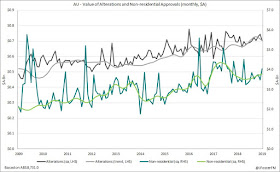The index has slowed from much stronger levels throughout 2018 driven largely by manufacturing, where firms have been impacted by weaker demand from clients in response to the trade uncertainties, though there were also signs that the more resilient services sector is beginning to turn down presenting clear risks for both investment and employment. It has been a similar theme of weakening manufacturing but stronger services sector activity in other major economies and this was repeated again on Friday with the official PMI reads for China easing further in May for manufacturing from 50.1 to 49.4 but holding steady for non-manufacturing at a solid 54.3.
Though less of a factor for markets, political uncertainty is likely to also be driving risk-averse sentiment. The provisional results from last week's European Parliamentary elections indicate that the two largest centrist parties (centre-right EPP and centre-left S&D) will maintain their majority, but in line with what the polls had predicted their support was fragmented by a shift to nationalist parties, including in the UK where Nigel Farage's Brexit Party clearly headed the voting. The other main development was in Italy where the far-right League party gained more than a third of the vote and was well clear of its coalition governing partner the Five-Star movement. The result saw League leader Salvini pushing his agenda for deep tax cuts, which has renewed concerns that Italy may again be set to clash with the EU's fiscal rules.
Throughout the week, global yields at the longer end of the curve fell away sharply as safety was sought from riskier assets. In the US, the 10-year treasury yield fell to its lowest since mid-2017 at around 2.12% to sit well inside the fed funds rate (2.25-2.5%), which is shown as our chart of the week, below. The fall was accelerated when overnight on Thursday Federal Reserve Vice Chair Clarida said that the Committee was prepared to respond with more accommodative policy if warranted by persistently low inflation and downside risks to their economic outlook. In its recent commentary, the Fed has been consistently constructive in their assessment of conditions and has described slowing inflation as 'transitory', thereby justifying its 'patient' stance on policy. Markets, however, clearly view rates as too restrictive at the current setting and are expecting a cut by October followed by 2 more by end-2020.
Chart of the week
—
The main development in Australia this week was a much weaker-than-expected update on business investment for the March quarter. Capital expenditure (capex) by the private sector fell by 1.7% in Q1 (the median forecast was +0.5%) driven by weakness in buildings and structures and equipment, plant and machinery providing another indication that next week's National Accounts are likely to show that activity in the domestic economy slowed further since the turn of the year (see our full review here). Firms' capex intentions were more constructive; plans for 2018/19 lifted by 3.8% on a year-to-year basis to $122.2bn, while estimate 2 for 2019/20 showed an increase of 12.8% through the year to $99.1bn. For 2019/20, capex plans indicated that mining sector investment is likely to turn and bring to end 6 consecutive years of decline from the peak in the cycle, while plans from the non-mining sector were broadly solid. The early indications appear supportive of the thesis of the Reserve Bank of Australia (RBA) that business investment will be a growth driver for the domestic economy over the next couple of years, though there are uncertainties given these are early estimates and were reported during the lead up to the recent federal election.
Also this week, dwelling approvals fell by a sharp 4.7% in April (the market forecast was for 0.0%) to be down by 24.2% on the level from a year earlier (see our review here). The deterioration in house approvals accelerated during April, while unit approvals weakened for both the low and high-rise segments. Weakening activity in the residential construction sector is in part driven by tight credit conditions, with data released by the RBA on Friday showing that housing credit growth slowed to a 3.9% annual pace — its lowest on record dating back to 1977. In the owner-occupier segment, credit growth eased to its slowest pace since mid-2015 at 5.5% in year-on-year terms, while credit has essentially stalled to investors (0.6%) over the past 12 months. Total private sector credit growth lifted by a softer-than-expected 0.2% in April, with the annual rate slowing to a 5½-year low of 3.7%.

































